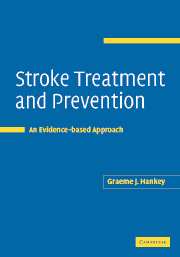Book contents
- Frontmatter
- Contents
- Preface
- 1 The size of the problem of stroke
- 2 Understanding evidence
- 3 Organised acute stroke care
- 4 General supportive acute stroke care
- 5 Reperfusion of ischaemic brain by thrombolysis
- 6 Augmentation of cerebral blood flow: fibrinogen-depleting agents, haemodilution and pentoxifylline
- 7 Neuroprotection
- 8 Treatment of brain oedema
- 9 Anticoagulation
- 10 Antiplatelet therapy
- 11 Carotid artery revascularisation
- 12 Lowering blood pressure
- 13 Lowering blood cholesterol concentrations
- 14 Modification of other vascular risk factors and lifestyle
- 15 Antithrombotic therapy for preventing recurrent cardiogenic embolism
- 16 Arterial dissection and arteritis
- 17 Treatment of intracerebral haemorrhage
- 18 Treatment of subarachnoid haemorrhage
- References
- Index
12 - Lowering blood pressure
Published online by Cambridge University Press: 23 December 2009
- Frontmatter
- Contents
- Preface
- 1 The size of the problem of stroke
- 2 Understanding evidence
- 3 Organised acute stroke care
- 4 General supportive acute stroke care
- 5 Reperfusion of ischaemic brain by thrombolysis
- 6 Augmentation of cerebral blood flow: fibrinogen-depleting agents, haemodilution and pentoxifylline
- 7 Neuroprotection
- 8 Treatment of brain oedema
- 9 Anticoagulation
- 10 Antiplatelet therapy
- 11 Carotid artery revascularisation
- 12 Lowering blood pressure
- 13 Lowering blood cholesterol concentrations
- 14 Modification of other vascular risk factors and lifestyle
- 15 Antithrombotic therapy for preventing recurrent cardiogenic embolism
- 16 Arterial dissection and arteritis
- 17 Treatment of intracerebral haemorrhage
- 18 Treatment of subarachnoid haemorrhage
- References
- Index
Summary
In the 1990s, it was established that there is a direct log-linear relationship between blood pressure (BP) levels and risk of stroke (MacMahon et al., 1990). It was also established that increasing BP is a causal risk factor for stroke; a systematic review of randomised-controlled trials (RCTs) showed that lowering BP significantly reduced the risk of first-ever stroke (Collins et al., 1990; Blood Pressure Lowering Treatment Trialists' Collaboration, 2000, 2003). Modest reductions in BP by about 10–12 mmHg systolic and 5–6 mmHg diastolic reduced the relative risk (RR) of stroke by about 38% and the RR of coronary heart disease by about 16% within a few years of beginning treatment. Larger (and smaller) reductions in BP produced larger (and smaller) reductions in risk of stroke. The five main classes of antihypertensive drugs (diuretics, β-blockers, calcium channel blockers, angiotensin-converting enzyme (ACE) inhibitors and angiotensin-receptor blockers (ARB)) were all effective in preventing stroke, and the magnitude of the effect was determined mainly by the magnitude of the BP lowering (Blood Pressure Lowering Treatment Trialists' Collaboration, 2000, 2003; Lawes et al., 2004).
For individuals who have already experienced a symptomatic transient ischaemic attack (TIA) or mild ischaemic stroke, there was observational evidence from the UK TIA aspirin trial of a similar direct and continuous relationship between BP (both systolic and diastolic) and recurrent stroke, as there was between BP and first-ever stroke (Rodgers et al., 1996). These data suggested that lowering diastolic BP by 5 mmHg was associated with a reduction in recurrent stroke by about a one-third (Rodgers et al., 1996).
- Type
- Chapter
- Information
- Stroke Treatment and PreventionAn Evidence-based Approach, pp. 288 - 295Publisher: Cambridge University PressPrint publication year: 2005



